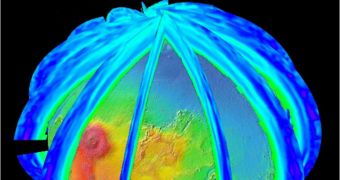With NASA and ESA working intensely on putting together their next cooperative mission, researchers at the JPL are doing their best to complete the advanced ExoMars Climate Sounder instrument on time.
This is one of the four scientific payloads that the American space agency needs to bring to the table. ESA, on the other hand, will supply the actual spacecraft, and another instrument, for a total of five.
The joint European-American mission is called the ExoMars Trace Gas Orbiter (TGO), and is at this point scheduled to blast off for the Red Planet in 2016.
It will be the job of the ExoMars Climate Sounder (EMCS) to conduct a wide variety of surveys each single day, including creating maps of the vertical distribution of temperatures, water vapors, dust and ice clouds.
These daily measurements will cover the entire surface of Mars each single day, and will most likely be taken from a polar orbit. On Earth, such orbits are used especially by spy satellites.
The reason why the EMCS is so important for the upcoming mission is the fact that it provides researchers analyzing the existence of trace gases in the Red Planet's atmosphere with a means of establishing a reference point.
“To put the trace-gas measurements into context, you need to know the background structure and circulation of the atmosphere,” explains Tim Schofield, who is based at the NASA Jet Propulsion Laboratory (JPL), in Pasadena, California.
The JPL is the organization in charge of building the Sounder, one of the four NASA TGO instruments
“We will provide the information needed to understand the distribution of trace gases identified by the spectrometers,” adds Schofield, who is also the principal investigator for the ExoMars Climate Sounder instrument.
“We'll do this by characterizing the role of atmospheric circulation and aerosols, such as dust and ice, in trace-gas transport and in chemical reactions in the atmosphere affecting trace gases,” he adds.
Datasets collected via this instrument will also be used to derive and calculate long-term trends affecting the Martian atmosphere, which may in turn help experts figure out how the planet evolved.
“We'll fill in information about variability at different times of day, and we'll add to the number of Mars years for understanding year-to-year variability,” Schofield explains.
“The most obvious year-to-year change is that some years have global dust storms and others don't. We'd like to learn whether there's anything predictive for anticipating the big dust storms, and what makes them so variable from year to year,” he concludes.

 14 DAY TRIAL //
14 DAY TRIAL //